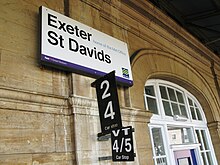Exeter to Plymouth line
| Exeter–Plymouth line | |
|---|---|
 |
|
| Overview | |
| Type | Suburban rail, Heavy rail |
| System | National Rail |
| Status | Operational |
| Locale | South West England |
| Termini |
Exeter St Davids Plymouth |
| Operation | |
| Opened | 1906 |
| Owner | Network Rail |
| Operator(s) | Great Western Railway |
| Technical | |
| Number of tracks | 2 |
| Track gauge | 1,435 mm (4 ft 8 1⁄2 in) standard gauge |
The Exeter–Plymouth line, also called the South Devon Main Line, is a central part of the trunk railway line between London Paddington and Penzance in the southern United Kingdom. It is a major branch of the Great Western Main Line and runs from Exeter, to Plymouth, from where it continues as the Cornish Main Line. It was one of the principal routes of the Great Western Railway which in 1948 became part of the Western Region of British Railways and are now part of the Network Rail system.
The line only became a through route on 2 July 1906 when the Langport and Castle Cary Railway was completed. Before this, from 5 May 1848, through trains from London to Plymouth had run via Bristol Temple Meads: this is often called the "Great Way Round" and a few trains still take this route.
The various sections of line were opened:
The Reading to Hungerford section was promoted as the Berks and Hants Railway; from there to Patney & Chirton by the Berks and Hants Extension Railway; and from Westbury to Castle Cary by the Wilts, Somerset and Weymouth Railway. The section from Cogload Junction to Exeter was built by the Bristol and Exeter Railway, which company's Yeovil branch became part of the new main line between Curry Rivel Junction and Athelney Junction, and including Athelney station. The section between Exeter and Plymouth was built by the South Devon Railway Company.
...
Wikipedia
